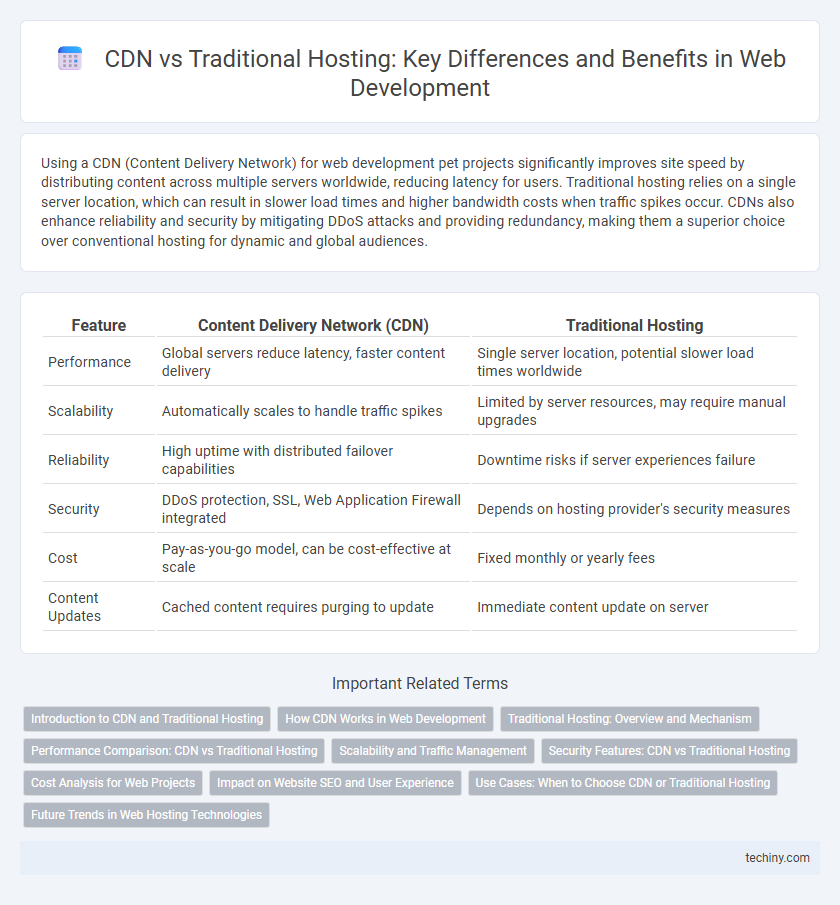Using a CDN (Content Delivery Network) for web development pet projects significantly improves site speed by distributing content across multiple servers worldwide, reducing latency for users. Traditional hosting relies on a single server location, which can result in slower load times and higher bandwidth costs when traffic spikes occur. CDNs also enhance reliability and security by mitigating DDoS attacks and providing redundancy, making them a superior choice over conventional hosting for dynamic and global audiences.
Table of Comparison
| Feature | Content Delivery Network (CDN) | Traditional Hosting |
|---|---|---|
| Performance | Global servers reduce latency, faster content delivery | Single server location, potential slower load times worldwide |
| Scalability | Automatically scales to handle traffic spikes | Limited by server resources, may require manual upgrades |
| Reliability | High uptime with distributed failover capabilities | Downtime risks if server experiences failure |
| Security | DDoS protection, SSL, Web Application Firewall integrated | Depends on hosting provider's security measures |
| Cost | Pay-as-you-go model, can be cost-effective at scale | Fixed monthly or yearly fees |
| Content Updates | Cached content requires purging to update | Immediate content update on server |
Introduction to CDN and Traditional Hosting
Content Delivery Networks (CDNs) distribute website content across multiple global servers, reducing latency and improving load speeds by serving data from the nearest server to the user. Traditional hosting relies on a single server or limited data center, which can create bottlenecks and slower response times during high traffic periods. CDNs enhance website performance, scalability, and reliability compared to traditional hosting by optimizing content delivery and reducing server load.
How CDN Works in Web Development
Content Delivery Networks (CDNs) enhance web development by distributing website content across multiple geographically dispersed servers, reducing latency and improving load times for users globally. By caching static assets like images, scripts, and stylesheets closer to the end-user, CDNs minimize the distance data travels, leading to faster content delivery and reduced server strain. This decentralized approach contrasts with traditional hosting, where all requests rely on a single origin server, often resulting in slower response times and potential bottlenecks under heavy traffic.
Traditional Hosting: Overview and Mechanism
Traditional hosting involves storing a website's files on a single physical server or a dedicated set of servers, typically located in one data center. This method relies on direct server access for content delivery, which can lead to slower load times and higher latency for users distant from the server's geographic location. Resource allocation and server management are handled manually or via control panels, making scalability and uptime dependent on local hardware and network infrastructure.
Performance Comparison: CDN vs Traditional Hosting
Content Delivery Networks (CDNs) significantly outperform traditional hosting by distributing website content across multiple global edge servers, reducing latency and accelerating load times for users regardless of their geographic location. Traditional hosting relies on a single server or data center, which can cause slower response times and higher server load during traffic spikes. Benchmark tests reveal that websites using CDNs experience up to 60% faster page load speeds and improved performance consistency compared to traditional hosting setups.
Scalability and Traffic Management
Content Delivery Networks (CDNs) offer superior scalability by distributing web content across multiple global servers, reducing latency and balancing traffic loads efficiently during high-demand periods. Traditional hosting relies on a single or limited number of servers, which can become bottlenecks under heavy traffic, leading to slower response times and potential downtime. Using CDNs enhances traffic management through intelligent routing and caching mechanisms, ensuring consistent performance and availability regardless of user location or traffic spikes.
Security Features: CDN vs Traditional Hosting
Content Delivery Networks (CDNs) enhance web security by offering distributed denial-of-service (DDoS) protection, web application firewalls, and secure HTTP/2 or TLS protocols, reducing the risk of attacks on a single server. Traditional hosting often relies on centralized infrastructure, making it more vulnerable to targeted cyberattacks and lacking integrated security layers found in CDNs. Leveraging CDNs improves overall site resilience through throttling malicious traffic and automatic SSL certificate management, features not typically present in standard hosting environments.
Cost Analysis for Web Projects
CDN solutions typically reduce overall costs by minimizing bandwidth usage and server load compared to traditional hosting, offering pay-as-you-go pricing models that scale with traffic demands. Traditional hosting often incurs fixed costs regardless of site performance, leading to potential overpayment during low traffic periods. Analyzing long-term expenses, CDNs provide cost efficiency through distributed caching and optimized content delivery, reducing latency and operational overhead for web projects.
Impact on Website SEO and User Experience
Content Delivery Networks (CDNs) improve website SEO by reducing load times through geographically distributed servers, enhancing user experience with faster page rendering and lower bounce rates. Traditional hosting can result in slower loading speeds and higher latency, negatively affecting search engine rankings and user engagement. Implementing a CDN increases site availability and performance, directly boosting SEO metrics and overall satisfaction.
Use Cases: When to Choose CDN or Traditional Hosting
CDN excels in delivering static assets like images, videos, and scripts with low latency to global audiences, ideal for high-traffic websites and applications requiring fast content load times. Traditional hosting suits dynamic web content with frequent database interactions, such as e-commerce platforms or custom applications where server-side processing is essential. Selecting CDN reduces server load and latency for distributed users, while traditional hosting offers control and flexibility for complex backend operations.
Future Trends in Web Hosting Technologies
Content Delivery Networks (CDNs) are increasingly integrating edge computing and AI-driven optimization to enhance load speeds and security, surpassing traditional hosting's centralized infrastructure limitations. Future web hosting trends emphasize decentralized architectures, including blockchain-based hosting solutions that promise greater resilience and transparency. As global internet speeds and user expectations rise, hybrid models combining CDN efficiency with scalable cloud resources will dominate web development strategies.
CDN vs traditional hosting Infographic

 techiny.com
techiny.com